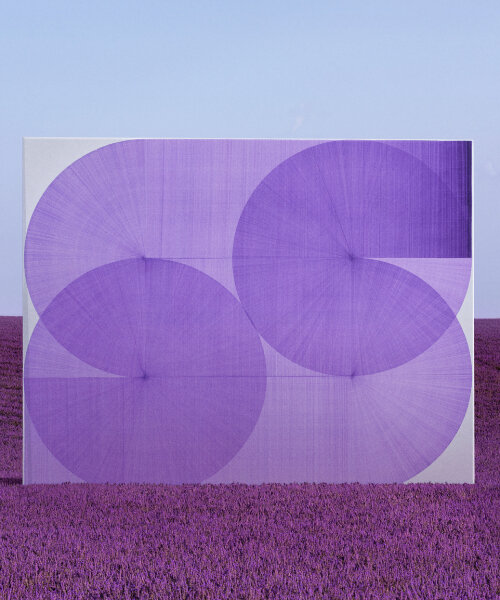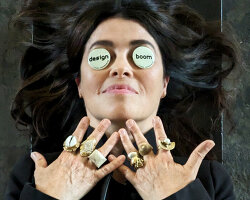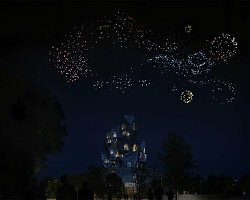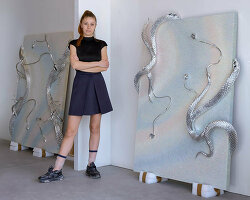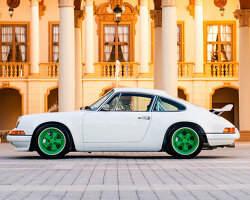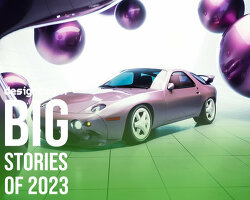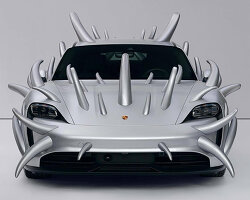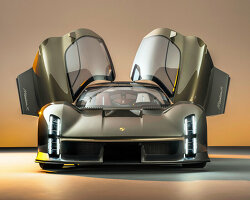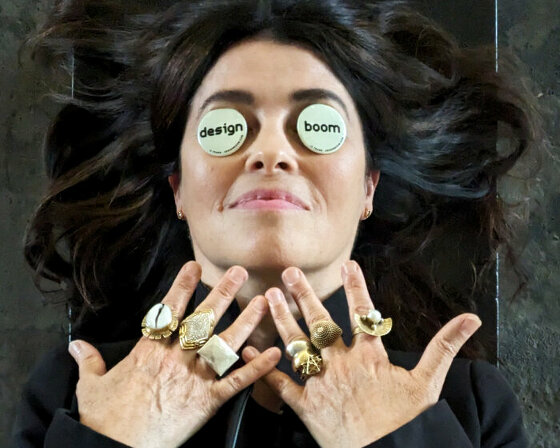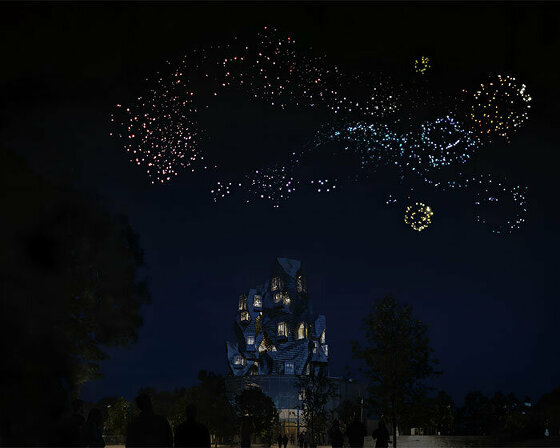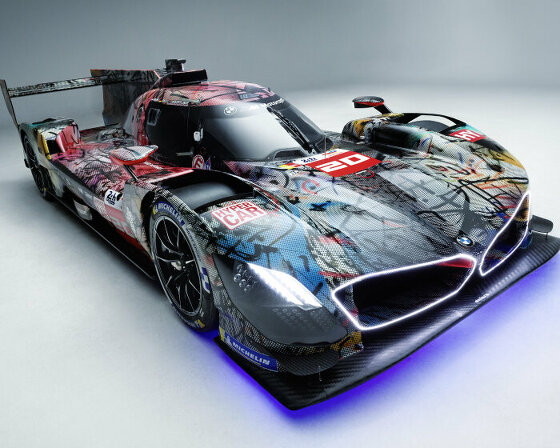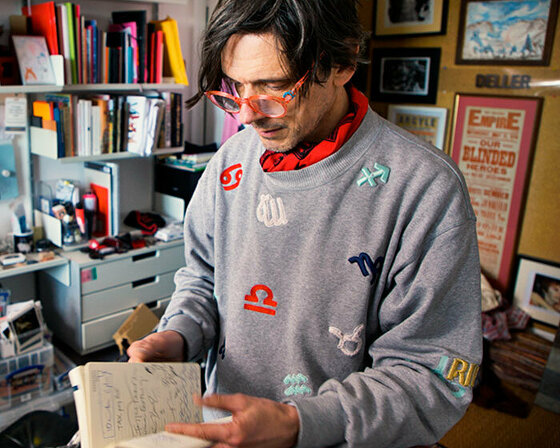explore Thomas Trum’s artworks for Porsche’s The Art of Dreams
Lavender is the talk of the town in Hyères, France, where Porsche’s The Art of Dreams enlists Thomas Trum for a series of artworks, including his acrylic-painted canvases ‘Southern Spins’, all inspired by its first-ever electric car, Macan. The Dutch artist spoke with designboom in an interview during the unveiling of his large-scale and ‘traveling’ artworks and paintings that span across the French Riviera, from a spray-painted tennis court doubling as an event space and a painted swimming pool to a bundle of purple mainsails for a sailing boat.
Thomas Trum’s large-scale artworks fall under the umbrella of The Art of Dreams, an initiative that Porsche launched in 2021 where they invite an artist or collective to create an installation based on the motif of dreams. These artworks and canvases were presented by the car manufacturer as the opening of the Design Parade Hyères festival, one of the renowned celebrations of design and creativity held at the Villa Noailles in Hyères, France, which runs between June 27th and 30th, 2024.
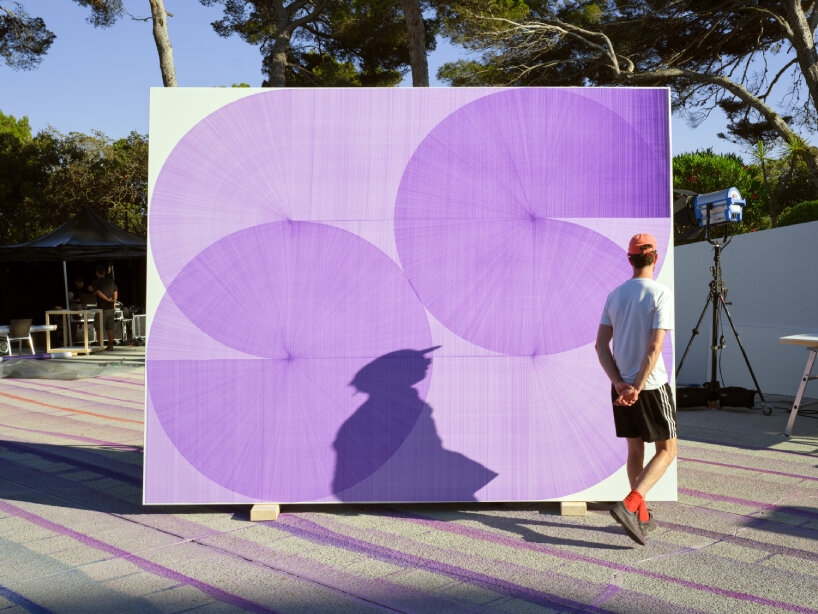
all photos by Thomas Lohr, courtesy of Porsche’s The Art of Dreams, unless stated otherwise
Lavender-nuanced canvases inspired by porsche macan
When Thomas Trum was young, he and his family took trips in their caravan, roaming around the countryside. The Dutch artist then saw endless fields that stretched on and wide, their expanse making him a part of them, of nature, rather than a miniature watching them from afar. One of the fields they would visit was of lavender, where rows of perennial flowering plants swayed with the winds, carrying the scent that wafted to him. His parents would fish out their camera and take photos of the scenery, which later ended up in the photobooks they have at home. A full-circle moment dawned on Thomas Trum when he sat down with designboom to speak about this in line with his artworks for Porsche’s The Art of Dreams.
Those lavender fields now appear in Le Provençal in Hyeres, France, formed as a series of large-scale canvases, a machine-sprayed tennis court, a painted swimming pool, and a bundle of purple-colored mainsails. Visitors to the event may step inside the court first, where Thomas Trum’s Southern Spins tower over them, albeit pinned to the wall. Below their feet, shades of purple over the cement floor evoke the imagery of hopscotch markings but chalked in paint. The electric Porsche Macan car is parked in the corner, a silk-like lavender cloth draping over half of its body to only reveal its front and part of its muted-lavender color. Surrounding the visitors are artworks that depict the nature of lines, spinning around, scraping the canvas, toppling over each other, their strips running almost endlessly throughout the canvases.
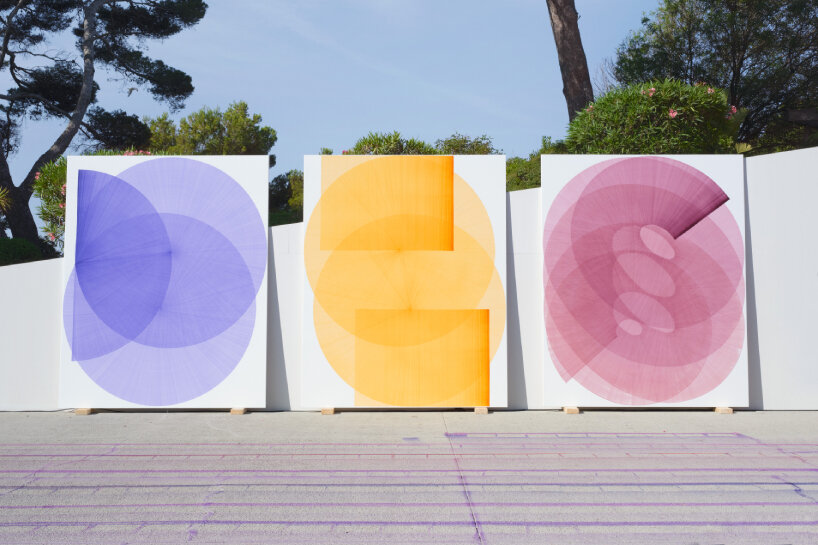
Thomas Trum’s Southern Spins canvases for Porsche’s The Art of Dreams in Hyères, France
Custom felt-tip pens and spray machine for the art of dreams
The sky, the sunsets, tomatoes, parasols, kites, flower fields, and grains in Provence. Thomas Trum turned to them all when he made the lavender-nuanced artworks for Porsche’s The Art of Dreams. The Dutch artist created his own marker using two pieces of wood and felt, resulting in custom large felt-tip pens. He dips his equipment in paint and rakes it over the canvas to produce the perfect lines.
Sometimes the imagery may weave twirling parasols seen from above or a fanning fan; other times, they recall the movement of Porsche Macan’s window wipers and the bamboo screens to shelter the interiors from the sunlight outside. Outside the painted tennis court, visitors descend and see the painted swimming pool. Once blue, the shade of lavender now springs up across its entirety, and its original color sometimes peeks through the purple coating, creating a hazy, psychedelic look similar to UV light.
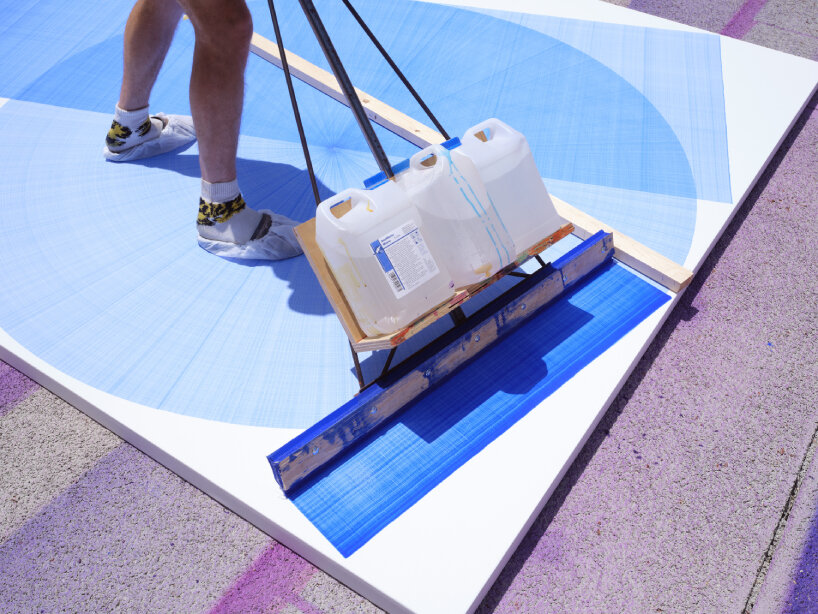
view of the custom ‘felt tip pens’ Thomas Trum used to paint Southern Spins
Water from the sea gushes and tries to fill up the pool, which the artist painted using agricultural machinery filled with lavender-colored paint. Not so far from the swimming pool, a sailing boat appears on the horizon, perhaps the only one that stands out in the blue sea through its mainsails that Thomas Trum designed too. One of them has a lighter pink shade, and the others have the hue of lavender, yet all of them seem to ripple as curvy white lines join the ensemble, replicating the waves of the sea in another color.
In our conversation with the Dutch artist below, he dives more into this along with his art practice, his relationship with lavender and colors, the agricultural machines he uses to make his paintings, his experience working for Porsche’s The Art of Dreams, and what he usually dreams about.
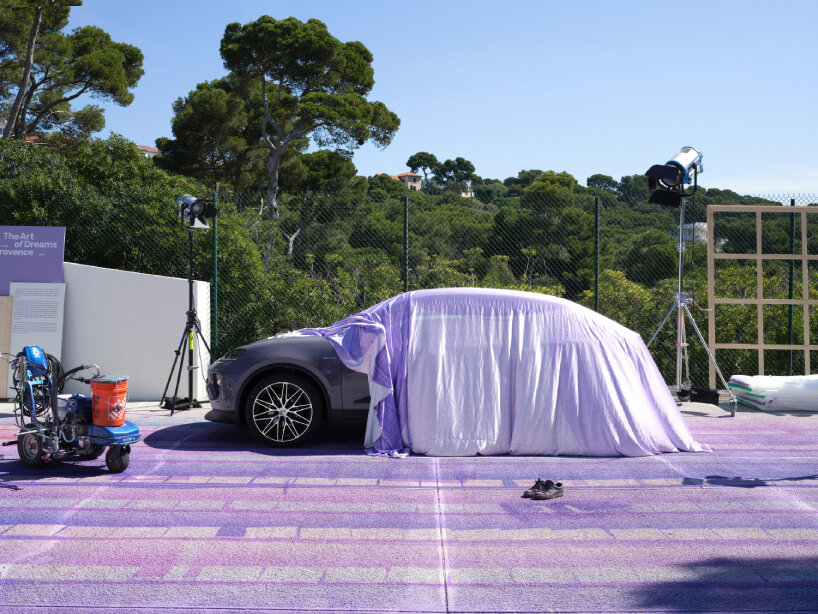
the Dutch artist spray-painted the tennis court with an agricultural machine
Interview with Thomas Trum
designboom (DB): Hi, Thomas, it’s so nice to meet you here in Le Provençal in Hyeres, France. We roamed around the other day and saw your large-scale canvases for the Southern Spins as well as the designs you made for the pool and the boat’s mainsails. How much time did you need to bring them to life?
Thomas Trum (TT): I came here a week before the unveiling, and for the canvases, they all came already done and we just put them all up. During my week-long stay, we painted the cover for the book (which contained all my artworks and distributed at the event) and the mainsails. For the court (design), it took us two days of full production to finish it, while the swimming pool took two hours for us to complete.
It was kind of quick because there were two components in general: the sea water and the paint. It’s kind of an offshore thing. You have the tub of paint, mix it, pour it in a spray machine, and that’s it. You couldn’t walk through it though, but then we had this film crew who would say, ‘Wait, we have the perfect shot.’ But I couldn’t stop; I had to continue spray painting with my machine and hoses. If the paint had dried up midway, it wouldn’t look the way it does now, and maybe it would have been bad for the machine, too.
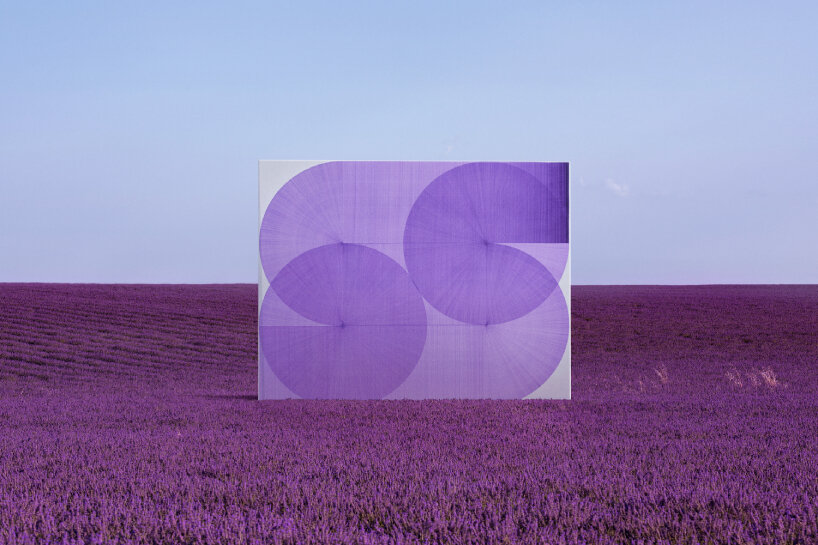
Thomas Trum turns to lavender fields as one of his influences for his artworks in Porsche’s The Art of Dreams
DB: And the other day, you had a public talk with Sabine Marcelis. You mentioned that it makes you feel a bit nervous when someone asks you if they can watch you make art. Do you feel a sense of intimacy when you make art, as if it were a personal time before you shared it with the public?
TT: Maybe, yes. Well, eight years ago, I made my first run in a large artwork size. I always closed the door, shut the windows of my studio to be totally alone, to be fully concentrated. And now, after years of practice and with my work getting better and bigger, I also need to work with assistants.
There’s this big piece that we made with four people where we dragged the whole marker, drying the paint and assisting each other. So, I’ve gotten used to having people around. But if you do a commission piece, they can ask you for something specific, and you can go wrong or have some flaws. It’s a bit tricky if a customer or a client is around and something goes wrong. That feels a bit more pressure.
DB: What happens to the canvases when something goes wrong?
TT: Lots of the paintings don’t go out of the studio. I mean, if they go out, then that means they’re good. They won’t be out of the studio’s door until they’re ready. Sometimes when we bring the artworks outside, it can be windy or rainy, and it can be tricky. Just like this morning, the canvas behind you fell down on a bucket of paint, so there’s a little dent in the canvas, but I think we can fix it.
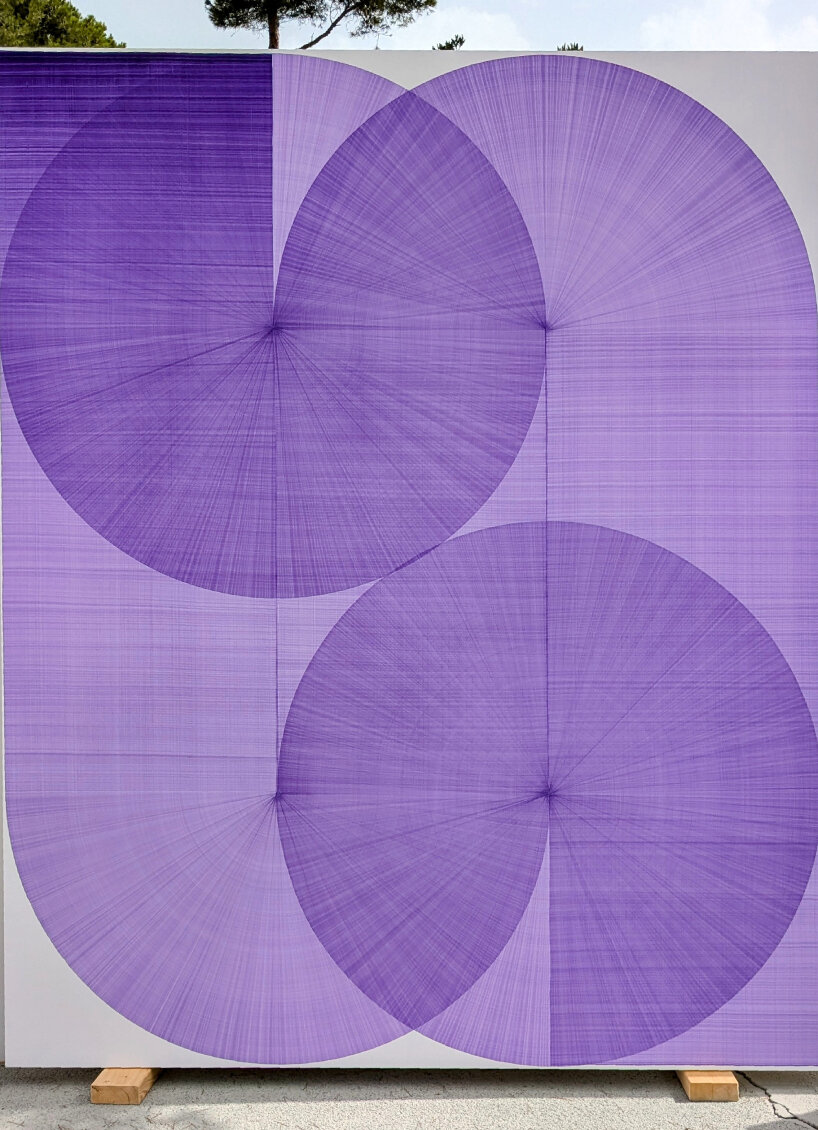
image © designboom
DB: How long will it take for you to fix it?
TT: I’m not sure, but with a heat gun and some water, you could slowly try to bring back the tension to the canvas and to its original form.
DB: While we were looking at the Southern Spins canvases, some of them could resemble parasols or bamboo screen rolls, similar to the ones typically found in Asian cities. We’re wondering if there are Eastern influences that you draw upon in your art practice?
TT: If you take a line and then make a form, you can easily come up with a letter or form that you can read (I think it’s because we are very used to reading). The world is about letters and education, and so if a letter appears on these canvases, I think it’s ruined; you look at it in a different way. So, I try to come up with forms that are very geometrical but also a bit more universal.
Maybe the Chinese or Japanese influences come through the act of making it better and always trying to perfect myself and make my artworks bigger. I see a lot of relationships there. I have only been to India and spent six weeks in Kolkata with an artist friend of mine in an artist residency. When I came back, the first thing I did was draw, which became the first one in this whole series. The trip inspired me, and I think everything was colorful. The use of color is so different from what we use in the Western world.
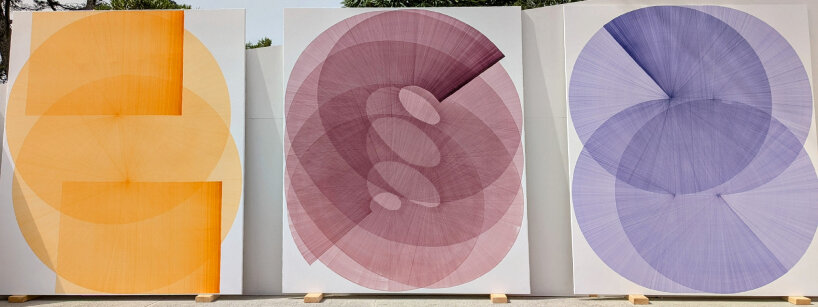
image © designboom
DB: What’s your favorite color?
TT: I feel like it’s in the direction of magenta or purple, but in general, I don’t think I have a favorite one.
DB: So, working with Porsche’s The Art of Dream for this series of artworks must be close to home for you in terms of color. We’re wondering: what’s your relationship with lavender as a flower and color? How do you see it?
TT: When I told my parents that I had a project with Porsche’s The Art of Dreams, they brought out this book full of photos from when we were young. We had this trip with the caravan and went to the lavender fields. I can’t remember where exactly, but they were far from home. If you look at these pictures, you can see these nice rows of lavender bushes that you want to dive into. I get a lot of my inspiration sitting on an airplane and looking down on aerial views, how landscapes are formed, how agriculture forms new landscapes.
I think the lavender fields are some of the nicest ones. They’re like plants that are there for a long time, growing, being trimmed, then growing again. They’re a perennial crop. And I like the smell of them, too. I heard someone who came to visit the show here say that the scent of lavender reminds them of their grandmother, and I really liked that. It’s crazy how smell has this kind of power. I mean, look at here (the artist points at the tree in front of us): you see here trees that are interacting with the wind and rain, but they also interact with me, with us. For me, I think the trees always win, or the flowers. They feel monumental as you look at them, or stand in front of or below them.
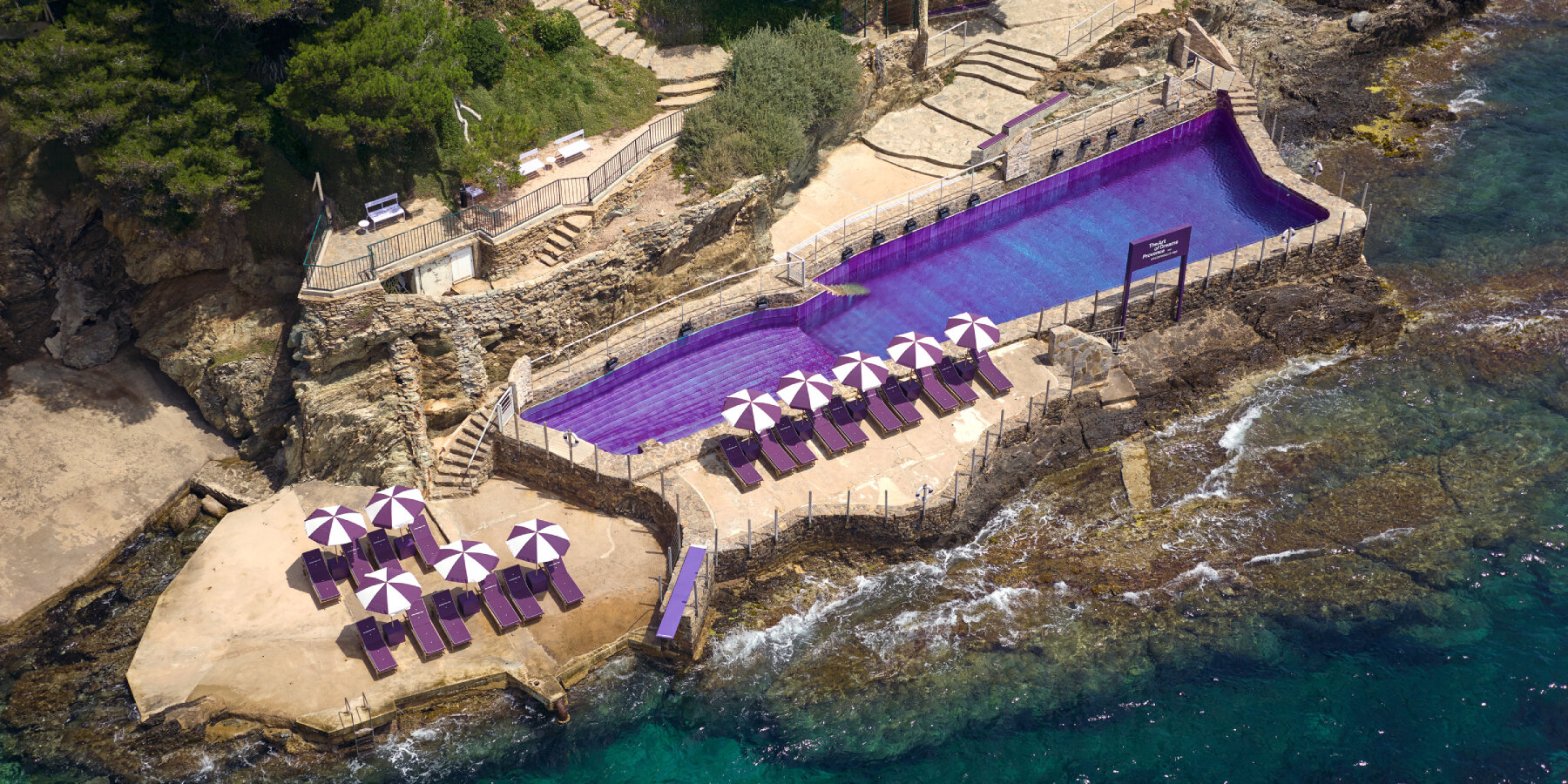
aerial view of the swimming pool sprayed with lavender-colored paint
DB: Is that how you observe your surroundings? You sit down and pay attention to their movement and features then put them into words?
TT: I think so. For example, I developed a new interest in mushrooms. I spoke with one of Porsche’s team members yesterday, and she said that her husband was totally into mushrooms. I feel that we had a look into this world of wonders, but for me, you can also see these transparent and visible lines of the mushrooms, which are fascinating. They have these geometrical shapes and deep relationship with nature.
I once did a show in Los Angeles called ‘Autobahn’ because I also get lots of inspiration from motion and movements. If you look at here (the artist is pointing at one of his canvases), you can see that the movement is almost literally like the wiper of a car. When it rains, all the cars are a bit dusty when they dry up, so you get this look of pineapples.
DB: We also read that when you make your large-scale artworks, you use agricultural machinery. Can you tell us more about that?
TT: These machines are like ‘sprayers.’ I also use custom pieces of felt, then of course, acrylic paint, but you can also do it with watercolor. But for this one (the Dutch artist points at the tennis court design), I used a high-pressure washer filled with paint. So, it’s spraying the paint without the use of air, and this machine came from the oil industry. I had to find a solution for how to pump fluids, then thought about how I could use this machine for painting. I use it to make perfect lines on parking lots and other large spaces.
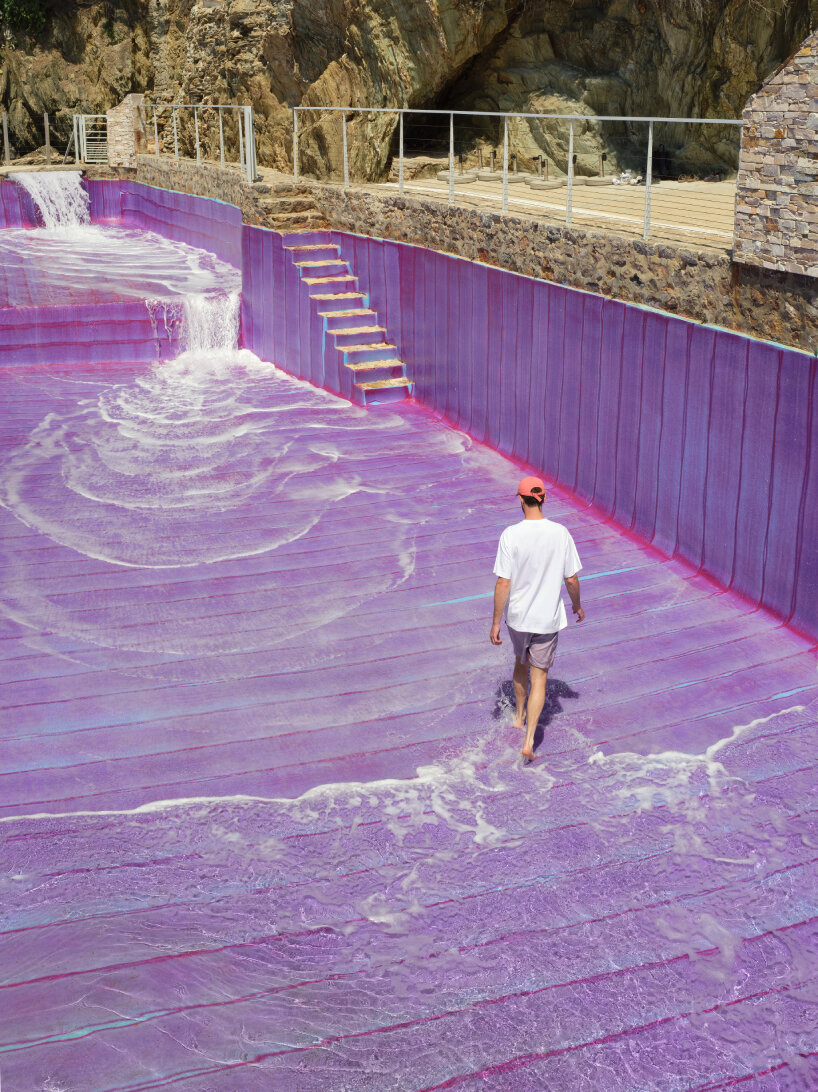
the water used comes from the nearby sea
DB: Do you have any experience working in the agricultural sector?
TT: Not really. I’m from the Netherlands, and we’re quite famous for farming, so while I don’t have a lot of experience myself, I do know that I’m quite fascinated by agriculture. I live in the countryside, and when I’m on a bike, I ride around the fields. Most of the time, I find a big tractor or sprayer rolling around the fields, and I find it fascinating. The lands in the Netherlands are flat, so they can be perfect for growing.
I’ve read before that when the country reclaimed the lands, we put out water and made them ‘flat’, so I think that was an ingenious way of working and, at the same time, efficient. I’ve heard there are plans to make a new airport by the sea, too. I think we’re quite good at working with water and making and retaining new lands. I’m interested in aquaculture as well as the scale of making land.
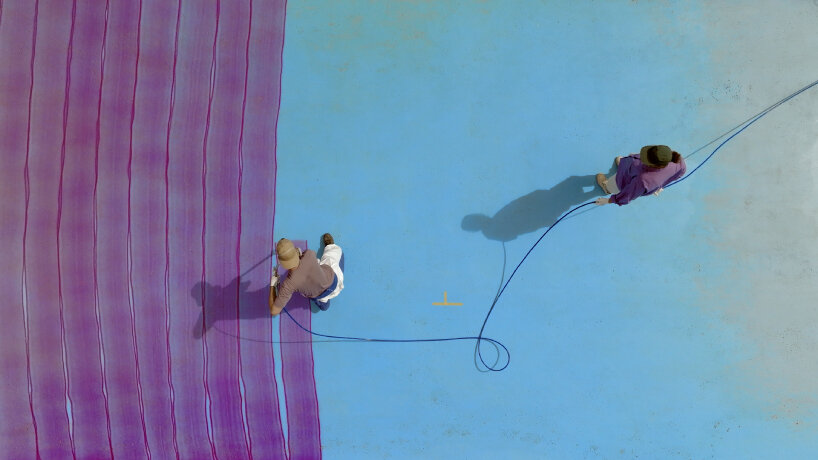
the making of Thomas Trum’s painted swimming pool for Porsche’s The Art of Dreams | still courtesy © fitzbrien
DB: It looks like you also made your land here at where we are right now, in this floor-painted tennis court.
TT: Yes, I think so. Also, with Porsche’s The Art of Dreams, they might have seen that, as an artist, I may be able to scale things up, and they were also interested in different surfaces. As a studio practice, I wanted to focus on paintings that can move, like the sea water used in the swimming pool and the mainsails for the sailing boat. They’re both paintings that move, as well as pieces of large-scale canvases. When the winds breeze through the mainsails and they flap, there’s a different kind of energy and power there.
With the sea water in the painted swimming pool, all the lavender-colored lines are made by hand. They’re not perfectly straight lines, and when the sunlight hits and the water breaks, you can see them clearly and it feels perfect. Just this morning, there was bird dirt in one of the Southern Spins artworks, but we applied a good UV-protection varnish, so it just slid down the canvas. Last night, there was a party here, and it was interesting to see that some people were scared of standing or dancing next to the real-life model of electric Porsche Macan here, but that they were fine doing so next to my artworks. I like it that way because normally in a museum, you’re not allowed to stand close to the artwork and here, there’s no barrier between you and my canvases.
DB: What did you feel when you first saw the electric Porsche Macan car?
TT: I Googled it, and its lavender color looked super bright, but when I received the car paint in a spray bottle and tested it, I thought, ‘there must have been a mistake.’ It was gray, a bit modest, kind of like a shade on the safe side. I still think Porsche did a good job at it.
DB: Would you say that that particular shade compliments the brightness of your canvases here, which have several shades of purple?
TT: Maybe yes, because the canvasses are white, and that color brings up everything to the front, making it quite bright.
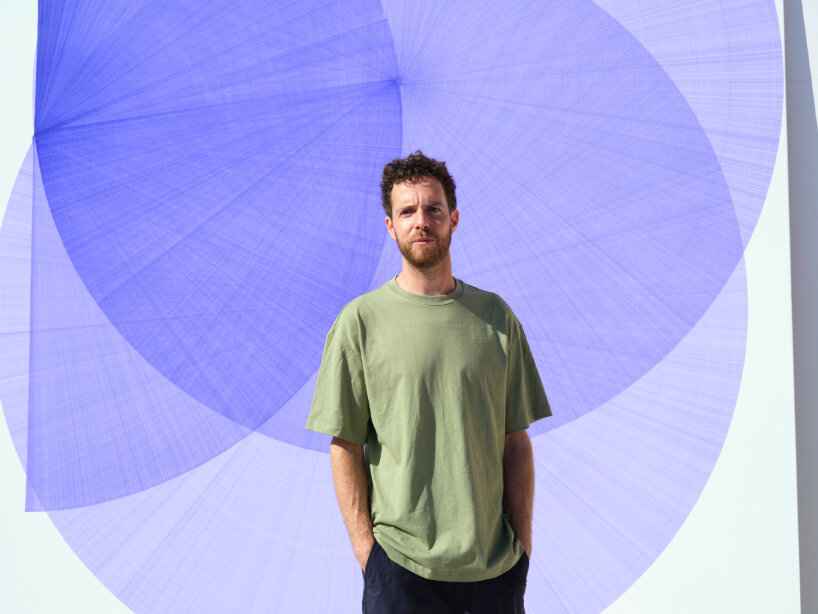
portrait of Thomas Trum
DB: Is there any agricultural machinery that you frequently use in making your artworks?
TT: It’s the sprayer machine, I think, because they work on land. You can spray this floor in literally 30 seconds, but when you use it in real life for another purpose, it can be used to kill lifes on Earth, like insects. I find that ironic. Sometimes, I think about what can be an interesting step after this, like maybe putting a tractor on the moon with a big plow and making a big smiley face there.
DB: Are the moon and the mushrooms set to be your next subjects for your future artworks?
TT: Someone once told me that mushrooms came from debris out of space, then it hit the earth, and life started. So, maybe it’s all connected, but I’m not interested yet in having an artwork out of the world, meaning on the moon.
DB: What do you usually dream about?
TT: Sometimes, I dream that I’ve taken too much ketamine, and I’m on the bottom of the ocean like this, as if we were living under the sea and above us was the surface of the water. Or that maybe this is all just a dream. Then, there are other realities. For example, I plan to take around six weeks off after the project with Porsche’s The Art of Dreams. A lot of big things have happened to me.
Maybe painting a swimming pool was a dream of mine five years ago, and now it’s here. I have to think about my next dreams now. Maybe I’ll foray into architecture, so I can work on a different scale. I think that would be very interesting. I mean, that field of arts has always been interesting to me, but I’m also interested in connecting it with architecture or design. Maybe it’s more functional than having a canvas on the wall, so I’m thinking of exploring their connections.
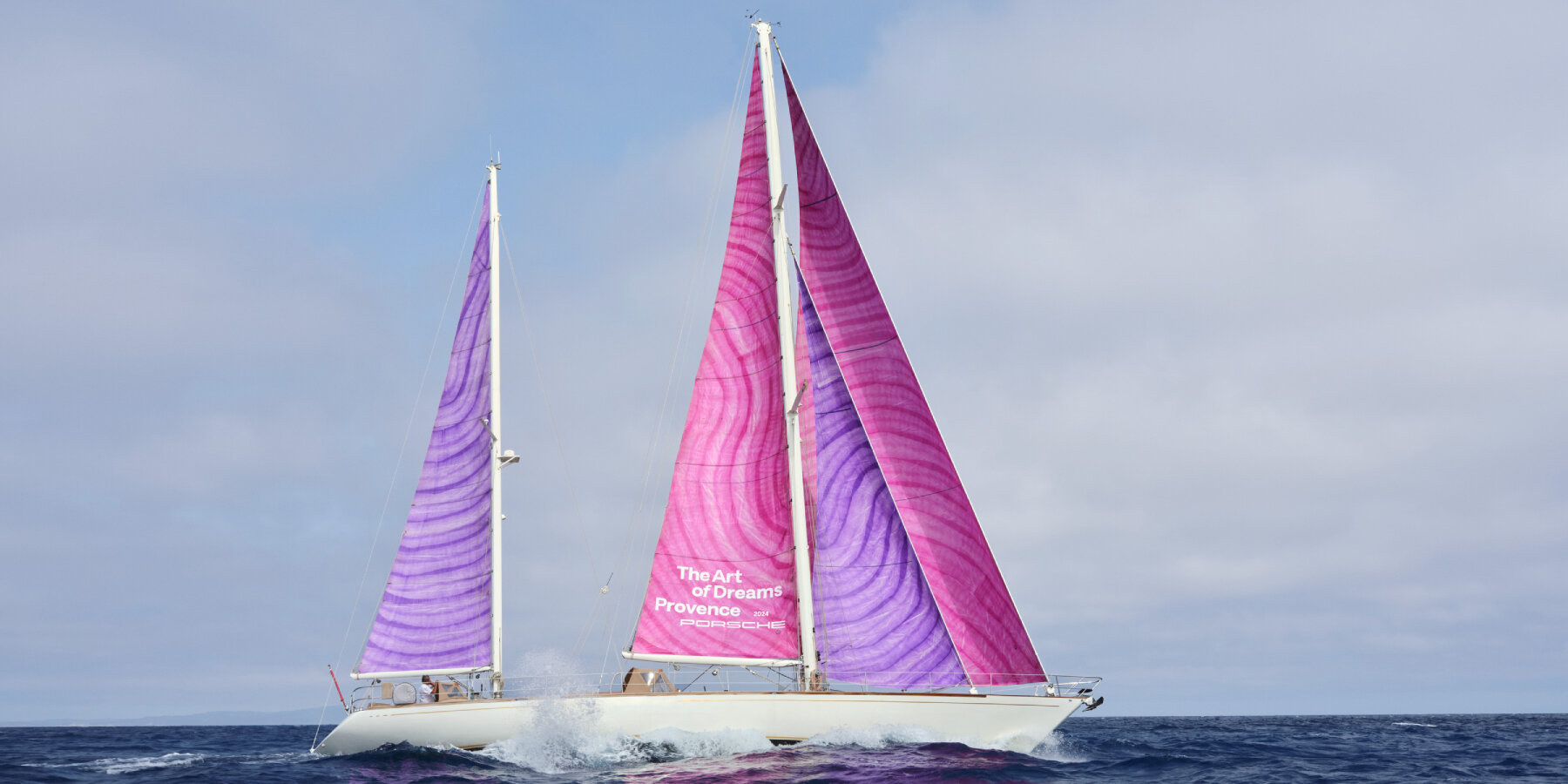
Thomas Trum’s mainsails for Porsche’s The Art of Dreams in Hyères, France
project info:
name: The Art of Dreams Provence
artist: Thomas Trum | @thomastrum
car manufacturer: Porsche | @porsche
initiative: The Art of Dreams | @porsche_theartofdreams
festival: Design Parade Hyères, Villa Noailles | @villanoailles
location: Hyères, France
dates: June 27th and 30th, 2024
photography: Thomas Lohr | @thomaslohrstudio
art interviews (133)
porsche (105)
PRODUCT LIBRARY
a diverse digital database that acts as a valuable guide in gaining insight and information about a product directly from the manufacturer, and serves as a rich reference point in developing a project or scheme.
